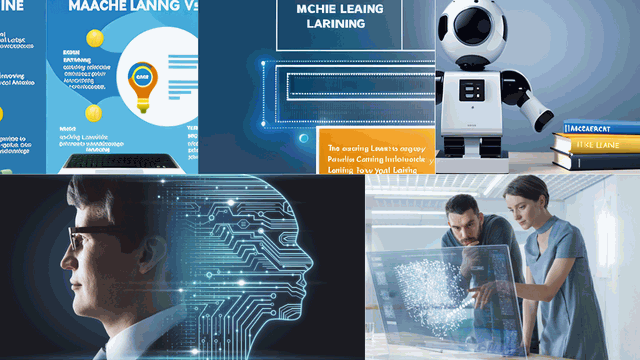IS MACHINE LEARNING THE SAME AS AI?
Preface
Although the terms artificial intelligence (AI) and machine learning are frequently used synonymously, machine learning is actually a subset of AI. But why does the big answer remain a NO?
Let us take you through the main context, its differences and similarities, its applications, and which is the best.

♦ Understanding the Terminology
In this context, the terms “machine learning” and “artificial intelligence” refer to technologies and algorithms that enable systems to recognize patterns, make judgments, and improve over time based on knowledge and data.
Whereas “artificial intelligence” refers to the general ability of computers to simulate human thought and carry out tasks in realistic settings.
♦ The Essence of Artificial Intelligence
One use of AI is in machine learning. It involves using mathematical models to analyze data in order to let computers learn without being explicitly instructed.
As a result, a computer system can keep picking up new skills and getting better on its own.
Computing intelligence systems are made possible by computer programmers and software developers using techniques like:
- deep learning for machines
- neural networks
- computer vision
- natural language processing
♦ What is Artificial intelligence?
The wisdom of creating computers and robots with intelligence that both mimics and exceeds that of humans is known as artificial intelligence.
Programs with AI capabilities can contextualize and analyze data to deliver information or automatically initiate operations without the need for human intervention.
Numerous of the technologies we use at the moment, such as smart bias and voice sidekicks like Siri on Apple, are powered by artificial intelligence.
Businesses are using methods like natural language processing and computer vision, which allow machines to understand images and human language, to automate jobs, speed up decision-making, and enable consumer conversations with chatbots.
♦ How Does Machine Learning Work?
Artificial intelligence can be attained through machine learning. The algorithms used in this branch of AI automatically learn insights and recognize patterns from data, applying that learning to make increasingly better decisions.
Programmers explore the limitations of how much they can enhance a computer system’s perception, cognition, and geste by probing and experimenting with machine literacy.
Advanced machine learning techniques like deep learning take things a step further. Deep Literacy models employ huge neural networks to learn complicated patterns and anticipate issues without the need for human input.
Neural networks behave similarly to the human brain in that they rationally interpret data.
♦ How Businesses Use Machine Learning and AI
Businesses must be able to turn their data into useful knowledge in order to succeed in nearly any endeavor. Organizations have the advantage of automating a range of homemade procedures involving data and decision-making thanks to artificial intelligence and machine literacy.
AI and machine learning are being incorporated into systems and strategic initiatives so leaders can understand and act on data-driven insights with greater speed and efficiency.
♦ Momentum
The maturity with which people interact with AI substantially through machine literacy You’ve presumably come across machine literacy in the following situations:
♦ on a website that streams videos, getting video recommendations.
♦ Using a chatbot to troubleshoot a problem online can guide you to the right resources based on your responses.
♦ Using virtual sidekicks that misbehave with your instructions to call someone, play a particular tune, or book meetings in your schedule.

♦ Benefits and outlook
Business and consumers alike can greatly profit from AI and machine learning. Businesses should anticipate lower expenses and improved operational efficiency, while consumers can anticipate more individualized services.
Thus, it should come as no surprise that the global demand for AI is anticipated to grow rapidly over the coming years.
Grand View Research (GVR) predicts that the size of the global artificial intelligence business will increase from $136.6 billion in 2022 to a staggering $1.8 trillion in 2030 [2]. Businesses that use AI and machine learning frequently reap the following advantages:
- the capacity to rapidly evaluate massive amounts of data to generate insightful, actionable knowledge.
- a higher return on investment (ROI) for related services as a result of lower labor expenses.
- enhanced client happiness and experiences that may be customized to satisfy specific client requirements.
♦ What similarities do machine learning and artificial intelligence share?
An extremely specialized area of artificial intelligence (AI) is machine learning (ML). But both of these areas go beyond simple programming and automation to produce results based on intricate data analysis.
Solutions based on artificial intelligence and machine learning (AI/ML) are best suited for complex tasks with precise results based on learned information.
For instance, a self-driving AI automobile navigates a vehicle using knowledge of traffic regulations and computer vision to identify things in its field of view.
For instance, a property pricing ML system uses information about location, floor layouts, market circumstances, and recent sales prices to forecast a home’s price.
Computer science subfields such as artificial intelligence and machine learning concentrate on developing software that can analyze, understand, and comprehend data in a variety of sophisticated ways.
In these domains, researchers work to develop computer programs that can carry out challenging, self-learning tasks. Software with good design will finish tasks.
Artificial intelligence is used in different kinds of fields. AI can be used to streamline supply chains, forecast sporting events, enhance agricultural results, and provide customized skincare advice.
The uses of ML are likewise varied. Predictive machinery maintenance planning, dynamic travel pricing, the detection of insurance fraud, and retail demand forecasting are a few examples.

♦ Major differences between machine learning and AI
Artificial intelligence (AI) has many subfields, one of which is machine learning (ML). Compared to AI, ML has a smaller scope and narrower emphasis. Many techniques and tools used in AI are outside the purview of machine learning.
Here are some significant variations between the two.
Any AI system’s objective is to have a machine efficiently execute difficult human tasks. These tasks could entail pattern recognition, problem solving, and learning.
On the other hand, the objective of ML is to automate the analysis of massive amounts of data. The machine will find patterns in the data and generate a result using statistical models. The outcome has a corresponding probability of accuracy or level of confidence.
There are numerous techniques employed in the field of AI to address a wide range of issues. These techniques include machine learning itself, genetic algorithms, neural networks, deep learning, search algorithms, and rule-based systems.
ML approaches can be broadly categorized into two groups: supervised learning and unsupervised learning. ML algorithms under supervision use input and output data values to train themselves to solve problems.
Unsupervised learning aims to unearth latent patterns in unlabeled data and is more exploratory.
♦ Creating an ML solution typically consists of two tasks:
♦ Choose and prepare a training dataset.
♦ Select a pre-existing machine learning technique or model, like a decision tree or linear regression.
Important data features are chosen by data scientists and fed into the model during training. The dataset is regularly improved with fresh data and error checking. The accuracy of the ML model is improved by high-quality and diverse data.
A lot of people select prebuilt AI solutions to accomplish their goals because creating an AI product is often a more difficult process. These artificial intelligence (AI) solutions are typically the result of years of research, and developers make them accessible for integration with goods and services via APIs.
For training, ML systems require a dataset with several hundred data points and adequate computing capacity. Your application and use case will determine if a single server instance or a small server cluster is adequate.
Depending on the task you wish to complete and the computational analytical methodology you apply, other intelligent systems may have varied infrastructure needs. Several thousand machines must cooperate in high-computing use cases in order to accomplish challenging objectives.
It’s crucial to remember that both prebuilt AI and ML functions are accessible. Without using extra resources, you can include them in your program via APIs.
♦ Is it better to learn AI or machine learning?
If you’re passionate about robotics or computer vision, for example, it might serve you better to jump into artificial intelligence. However, if you’re exploring data science as a general career, machine learning offers a more focused learning track.
Below is a breakdown of the differences between artificial intelligence and machine learning as well as how they are being applied in organizations large and small today.
Conclusion
In summary, the difference is clear, and the answer to the subject matter of whether Machine learning is the same as AI is a big No. They are never the same, but they may share the same similarities.
FAQs
♦ What is the relationship between machine learning and artificial intelligence?
While machine learning is a subset of man-made reasoning, artificial intelligence envelops a more extensive scope of capacities past gaining from information.
♦ How do organizations profit from carrying out machine learning and AI?
Organizations can encounter lower costs, worked on functional productivity, and the capacity to offer more customized administrations to purchasers.
♦ What are a few critical utilizations of artificial intelligence in this day and age?
Artificial intelligence is utilized in different fields, from robotizing assignments like client assistance with chatbots to making expectations in regions like games and agribusiness.
♦ What are the primary distinctions in targets among machine learning and AI?
AI expects to empower machines to perform complex human undertakings, while machine learning centers around dissecting information to create results.
♦ Which is more reasonable to learn, machine learning or AI?
The decision relies upon your particular advantages. In the event that you’re keen on mechanical technology or PC vision, AI may be the better decision. For an engaged vocation in information science, machine learning might be the way to take.
Access Now: https://bit.ly/J_Umma







